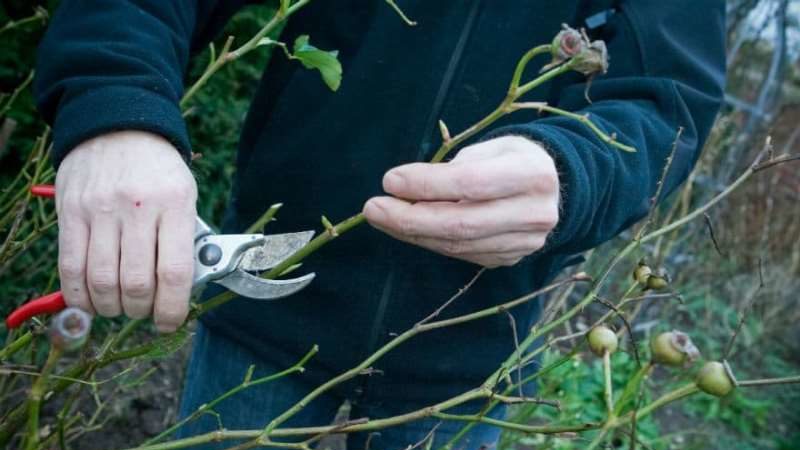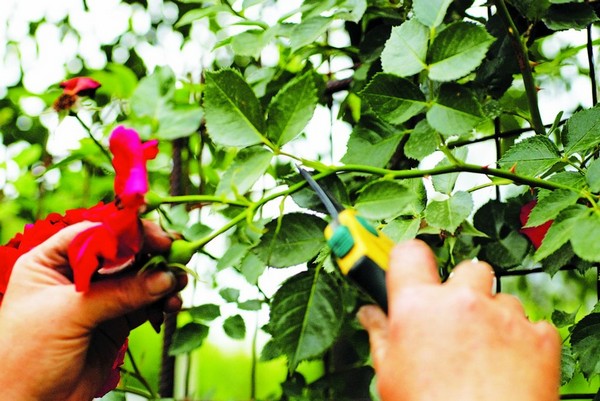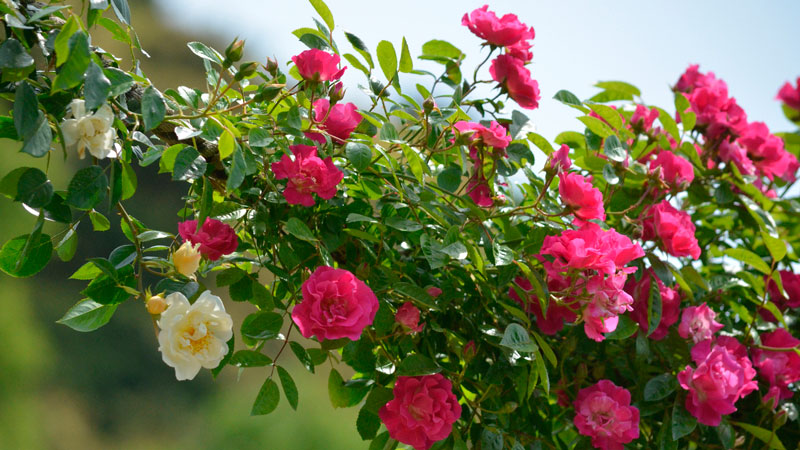Why do you need pruning a climbing rose after flowering in summer and how to carry it out correctly
Pruning a climbing rose after flowering in the summer is a must-have procedure that maintains bud formation this year and next season. The procedure promotes the development of replacement shoots in once-flowering roses, and in remontant roses it stimulates the second wave of flowering. How to properly cut climbing roses and what to do next, we will tell in the article.
The content of the article
Why prune climbing roses after flowering in summer

It is believed that climbing roses do not need pruning. However, without this procedure, the bushes grow strongly, which makes it difficult to access the inner branches.
If space permits, the increments are formed horizontally. As a result, many flower-bearing branches are formed, and the bushes stand in bloom, attracting attention. This formation simplifies care for a climbing rose. On vertical stems, only a few apical shoots with flowers are formed.
Pruning climbing roses is a guarantee of lush flowering, but the main purpose of the procedure is not to form a bush and stimulate bud formation.
It involves solving completely different problems:
- organization of a high-quality skeletal base;
- removal of old and dry shoots;
- stimulating the growth of replacement branches;
- sanitary haircut;
- removal of limp flowers.
Climbing roses are able to self-rejuvenate due to the appearance of young branches instead of old, unproductive stems. Pruning is just help from the grower to keep the bushes in perfect condition.
Particular attention is paid to the development of replacement shoots, since climbing roses bloom on last year's growth. The main task of the rose grower is to get strong shoots that can bloom magnificently in the coming season.
Summer pruning has another important goal - flowering control. This procedure is called regulatory. It supports bud formation and proper development of replacement shoots in once-flowering roses, and in re-flowering roses it stimulates the second wave of flowering.
Terms of the procedure
Climbing roses are cut after flowering: in late summer - early autumn.
Auspicious days in 2020:
- July: 1-3, 7-18, 22-31;
- August: 1, 5-10, 12-17, 21-24, 26-31;
- September: 1-3, 6-13, 18-24, 29, 30.
Auspicious days in 2021:
- July: 3-8, 13-17, 19-23, 27, 28, 31;
- August: 1–6, 10–15, 17–19, 23, 27–31;
- September: 1–3, 8–13, 15, 16, 19, 20, 24–30.
Types of trimming
To form garden roses, 4 types of pruning are used: sanitary, rejuvenating, regulating and stimulating.
Sanitary involves the removal of black, brown, brown-spotted branches. They are cut immediately after the bushes are freed from the winter shelter. Attempts to rescue damaged stems do not give the expected results - they still dry out and often become a source of spread of diseases. Shoots are cut in stages to healthy wood so as not to remove excess, then harvested and burned.
Anti-aging pruning - a radical procedure aimed at prolonging the life of the rose. The biological cycle of a flower involves shearing old branches to stimulate the emergence of replacement shoots. The plant has an amazing ability to regenerate, and such pruning only prolongs its life. With proper care, a rose can grow in the same place for over 20 years.Neglect of radical pruning dooms the bush to slow aging and death. Old branches are removed to the ring. The procedure is performed in the spring.
Reference.If the rose has noticeably weakened and slowed down its growth, growers carry out radical pruning and leave 2-3 strong shoots on the bush, and the rest are cut into a ring.
Formative pruning is performed to give the bush a vase-like shape. To do this, remove weak branches from below: they will never bloom. Of the 2 competing shoots, the strongest is left. The technique is used when only one of the three branches that have emerged from the bud is required. To evenly illuminate the bush with the sun, flower growers cut out part of the second-order shoots.
Stimulating pruning causes the rose to release new shoots. The rule is observed in the work: the weaker the shoot, the more it is cut off, and vice versa.
How to properly prune climbing roses after flowering
The main pruning of climbing roses is done after flowering. The work begins by removing old branches. Basal faded shoots are shortened at the base, and a frame is formed from young branches. If there are few young shoots, the old branches are shortened to 30–40 cm.
Pruning re-blooming roses is easier. Florists remove faded stems up to the first apical five-leafed leaf. Without this, the development of growth on roses is delayed by 2-3 weeks, which negatively affects flowering in the next season, and in some cases reduces the chance of seeing even an insignificant second wave by 90%.
If by the middle of summer a sufficient number of shoots have not appeared on the bushes, young branches are laid horizontally or spud up to a height of 30–40 cm to stimulate shoots. If grafted climbing roses or formed into a stem grow on the site, in addition to the standard summer pruning, a regular inspection is carried out for wild growth, which is important to remove in time.
Required materials and tools
Sharply sharpened tools are used to trim climbing roses:
- special saw;
- a long-handled pruner or brush cutter;
- secateurs.
The pruner with two cutting blades works like a conventional scissor. The tool makes a clean and even cut, does not crush shoots and does not delaminate the bark. It is advisable to have a separate pruner for working with roses and not use it, for example, for cutting raspberries. The tool is disinfected with medical alcohol or a solution of potassium permanganate before work, periodically sharpened and lubricated with machine oil before storage.
A lopper with sturdy handles is used to remove thick branches. It works like a lever. The garden saw is suitable for removing old, thick shoots that cannot be used with other tools.
To protect your hands from cuts and scratches, it is recommended to cut with suede or leather gloves, in extreme cases - from a thick tarp with high cuffs.
Pruning schemes
Stimulating pruning of climbing roses after flowering is especially important to create a dense wall or fence.
Pruning climbing roses is divided into 4 groups depending on the type of growth and formation of shoots:
- To the first group include roses blooming in June - July on the basal shoots of last year's branches (Dorothy Perkins, Excelsa). In the spring, the bush is given a horizontal shape. On the shoots of the previous year, buds are abundantly tied, and new branches continue to form in the same direction. In September, cut off the faded shoots, except for 2-3 last year. Lateral shoots are shortened by 2–4 buds.

- Second group of roses develops similarly to the first. The only difference is a small amount of root growth. Summer flowering will begin on last year's shoots, and the basal ones will later become “guides”. At the end of summer, the branches of the last year are cut into "conductors", the faded lateral and weak stems are shortened by 2-3 buds. The bush blooms on horizontally formed stems from last year and shortened shoots.Root and replacement shoots begin to grow.
- Roses of the third group bloom on the shoots of the current year, differ in thin and flexible stems, which allows them to be used to decorate arches, pergolas, walls, arbors, fences. The long branches form the main skeleton in a horizontal direction or at a slight angle. In summer, the basal stems are tied up, faded buds and weak branches are removed.
- Fourth group roses are characterized by a pyramidal shape, moderate growth rate, less flexible stems. Flowers appear on the shoots of the current year. The length of vertical stems does not exceed 3 m. Roses are used for vertical gardening, long stems are tied to a support. Flowering occurs on last year's shoots. Faded buds are periodically removed, weak and diseased branches are cut into 2-3 buds. To give symmetry, several developed branches are removed at once. To stimulate the development of basal shoots, the old ones are cut off by 2/3 of the length.
Step-by-step instructions for pruning
Rules for pruning climbing roses:
- A clean and disinfected instrument is used in the work.
- The cut is made at an angle of 45 ° so that it goes down from the kidney. This will prevent stagnant water.
- When choosing a pruning point, it is advisable to focus on developed buds, which are usually located on the outside of the shoot. New branches will grow outward rather than into the center of the bush.
- When removing the shoot, it is important to ensure that 5–8 mm of the stem remains above the developed bud.
- With a sanitary shearing, the cut is made to healthy wood. Thin, weak, unproductive, growing inward branches are removed to the base.
- Only 1 shoot is left from each bud.
- Such a number of shoots are maintained on the bushes, which guarantees good illumination and ventilation inside.
All cuts on roses are treated with garden varnish or a special Ranet paste to prevent the development of infections.
Features of the procedure for different varieties of climbing roses

Single blooming ramblers faded branches are cut into a ring immediately after flowering. This stimulates the emergence of new shoots in the next season. The method is used mainly in the south.
In the middle lane, where warm summers and long mild autumn are rare, such a haircut is performed before sheltering for the winter. With good nutrition, new lashes grow back even without additional stimulation. In grafted ramblers, 3–6 shoots are left, in self-rooted ones - 20. After flowering, the crown of young stems is shortened by 5–7 cm to stimulate the regrowth of lateral branches.
Large-flowered climbers and shrubs are semi-leafy roses that bloom repeatedly. The main pruning of such varieties performed in spring, simultaneously with a sanitary haircut. The lashes are shortened to the first strong kidney. In summer, after flowering, 1/3 of the length of the shoots is removed. This will provide active branching and stimulate a new wave of bud formation.
Reference. Old shoots are cut in the fall up to 30 cm above ground level, and 2-3 buds are left at the side ones.
Attempts to form spray roses from climber or a tall shrub cause great damage to the plant. It will spend energy on the formation of new shoots, which will bloom only in the second half of summer.
Shrubs exposed to light corrective pruning. In once-blooming roses, it is performed in the summer, after flowering, in remontant roses, in the spring. The branches of high scrubs are cut by 1/3, low ones - by 1.2 m. Faded buds are removed without fail. 3 years after planting, 1-2 old shoots are removed annually. For once-flowering scrubs, the procedure is performed in spring and summer.
Ground cover roses, many of which are part of the scrub group, correct dense growth. In the spring, old shoots are cut out and a curly haircut, giving the bush the shape of a ball.
Care after pruning
Top dressing climbing roses plays an important role in their development and flowering.Some gardeners prefer ready-made fertilizers (for example, Agricola for roses), others make them themselves.
Scattered under the bushes are granulated feeding and embed them in the ground. Nitrogen fertilizers are applied in the spring, potash-phosphorus compositions are used in the summer.
Reference. In the second half of summer, climbing roses are fertilized with "Kemira universal", "Gloria". To stimulate the appearance of buds, the preparations "Epin", "Zircon", "Bud" are used.
During dry periods, the rose garden is moistened 2 times a day. For irrigation, use warm, settled water, which is poured under the root, without falling on the leaves and buds.
Climbing roses more often than other varieties suffer from infectious diseases and are attacked by insects. Gardeners have to deal with aphids and spider mites, leaf rollers, thrips. Plants are processed when the first signs of infection are detected. To do this, use the insecticides "Karbofos", "Sharpey", "Inta-Vir", "Fufanon", "Fitoverm", "Aktellik", "Aktara", "Fosbecid".
Climbing roses are sick with rust, powdery mildew, gray mold. For treatment, fungicides are used (“Horus”, “Delan”, “Rubigan”, “Previkur”, “Ditan M-45”, “Ridomil Gold”). The most dangerous disease in culture is bacterial cancer. Infected bushes have to be uprooted and burned, as there is no cure.
Before wintering, the shoots of climbing roses are examined, all leaves are removed. The stems are removed from the supports and cut. To stimulate flowering 2-3 weeks earlier, the cardinal pruning do not fulfill, but provide enough free space to hide bushes. Shoots are treated with antifungal agents, the lower part is insulated with sand, peat, spruce branches. The branches are tied in bunches and placed on spruce branches. From above, the bushes are covered with non-woven cloth, earth, dry branches, straw, and in winter they cover with snow.
In regions with snowy winters, they reduce the load on the stems by warming roses in arcs. Tall climbing plants are not removed from the supports, but carefully insulated with spunbond or lutrasil. They put soil on the root part and put spruce branches.
Tips from experienced florists

Tips from experienced florists to help maintain the abundant flowering and health of climbing roses:
- Due to the specific characteristics of the plants, they need support. A wall of a house, a fence, a gazebo, a mesh fence are perfect for this.
- The branches are fixed horizontally so that the rose blooms along its entire length. If you attach them vertically, the buds will form only at the tops.
- Plastic twine is used as a fastening material. It securely fixes the shoots and does not damage them.
- Laying old bushes for the winter is a laborious process that often takes a week. The procedure is performed strictly at above-zero air temperature, since the stems break in the cold.
- To prevent insect damage to the bushes, strong-smelling flowers are planted nearby: marigolds, calendula, odorous dill.
Conclusion
Climbing roses can transform any building, be it the wall of an unremarkable country house, a mesh fence or an old wooden gazebo. In order to properly form the bush, maintain flowering and stimulate its second wave, bushes are trimmed in summer. Florists remove dead, old, dry and damaged shoots, flabby buds and leaves.
In work, they use a special saw, a trimmer or brush cutter with a long handle, a pruner. All sections are made at a 45 ° angle to prevent water retention in the kidney. After pruning, the plant is fed with potassium and phosphorus, watered if necessary and cover the branches for the winter before the onset of frost.